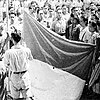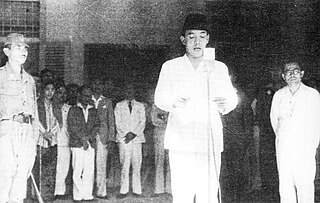
The Indonesian National Revolution also known as the Indonesian War of Independence, was an armed conflict and diplomatic struggle between the Republic of Indonesia and the Dutch Empire and an internal social revolution during postwar and postcolonial Indonesia. It took place between Indonesia's declaration of independence in 1945 and the Netherlands' transfer of sovereignty over the Dutch East Indies to the Republic of the United States of Indonesia at the end of 1949.

Adam Malik Batubara was an Indonesian politician, diplomat, and journalist, who served as the third vice president of Indonesia from 1978 until 1983, under President Suharto. Previously, he served in a number of diplomatic and governmental positions, including Speaker of the People's Consultative Assembly from 1977 to 1978, Speaker of the People's Representative Council from 1977 to 1978, Foreign Minister of Indonesia from 1966 until 1977, and president of the United Nations General Assembly from 1971 until 1972.

Sri Sultan Hamengkubawono X is the Sultan of the historic Yogyakarta Sultanate in Indonesia and is currently also the Governor of the modern Yogyakarta Special Region.

Sri Sultan Hamengkubuwono IX (Hanacaraka: ꦯꦿꦶꦯꦸꦭ꧀ꦡꦟ꧀ꦲꦩꦼꦁꦑꦸꦨꦸꦮꦟ꧇꧙꧇, often abbreviated as HB IX was an Indonesian politician and Javanese royal who was the second vice president of Indonesia, the ninth sultan of Yogyakarta, and the first governor of the Special Region of Yogyakarta. Hamengkubuwono IX was also the chairman of the first National Scout Movement Quarter and was known as the Father of the Indonesian Scouts.
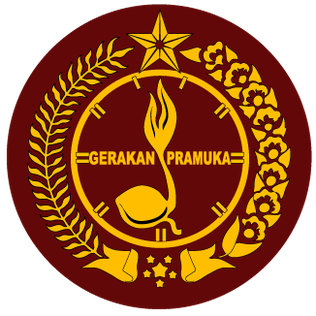
The Pramuka Movement of Indonesia, officially the Praja Muda Karana Scouting Movement, is the national scouting organization of Indonesia. Scouting was founded in the Dutch East Indies in 1912, and Indonesia became a member of the World Organization of the Scout Movement (WOSM) in 1953. Regulated by the Pramuka Movement Act of 2010, all elementary and secondary schools must operate a scouting program; and membership was compulsory for students in elementary and secondary schools from 2014 to 2024. It has 21,599,748 members, making it the world's largest Scout association.

The Sultanate of Yogyakarta is a Javanese monarchy in Yogyakarta Special Region, in the Republic of Indonesia. The current head of the sultanate is Hamengkubuwono X.
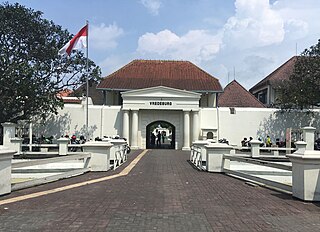
Fort Vredeburg Museum was a former colonial fortress located in the city of Yogyakarta, Special Region of Yogyakarta, Indonesia. The military complex has been converted into a museum of the Indonesian independence struggle which was opened in 1992. It is located in front of Gedung Agung and near the Kraton Yogyakarta.

The Treaty of Giyanti was signed and ratified on February 13, 1755, between Prince Mangkubumi, the Dutch East India Company, and Sunan Pakubuwono III along with his allies. The accord officially divided the Sultanate of Mataram between Mangkubumi and Pakubuwono. The name "Giyanti" was taken from the location of the signing of the agreement, namely in Giyanti Village which is now located in Hamlet Kerten, Jantiharjo Village, southeast of Karanganyar, Central Java.

This is the timeline of Indonesian National Revolution.

The Bandung Great Fire refers to the deliberate burning of much of the southern side of the city of Bandung by retreating Indonesian Republican troops during the Indonesian National Revolution.

Ali Murtopo was a prominent Indonesian general and political figure during the first half of General Suharto's New Order regime.

Suharto was the second President of Indonesia, having held the office for 31 years from 1967 following Sukarno's removal until his resignation in 1998.
The 3 July Affair in 1946 was a political upheaval in the then newly formed Republic of Indonesia. The Prime Minister, Sutan Sjahrir, was kidnapped by factions within the military opposing the Republic’s negotiations with the Dutch during the Indonesian National Revolution. It ended with the release of Sjahrir and a re-structure of both the Republican government and the army.
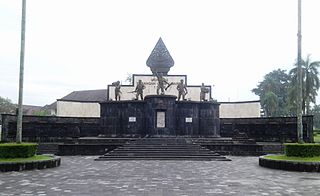
The General Offensive of 1 March 1949 was a military offensive during the Indonesian National Revolution where the city of Yogyakarta was held by Indonesian troops for six hours. This played an important role in causing international pressure to be exerted on the Netherlands.

The Yogyakarta Kraton Guards are the contingents of soldiers guarding the Kraton Ngayogyakarta Hadiningrat, the official residence of the Sultans of Yogyakarta. They serve ceremonial and security functions. By tradition, the reigning Sultan of Yogyakarta serves as Colonel-in-chief of the Guards.
The following is an order of battle of the Indonesian National Armed Forces as of 8 January 1946, after the then People's Security Armed Forces was transformed into the People's Safety Armed Forces by Presidential Resolution #2/1946.

The Battle of Semarang, in Indonesia also known as Pertempuran Lima Hari was a clash between Japanese forces of the Sixteenth Army and Indonesian forces consisting of People's Security Agency personnel and pemuda in October 1945 at the city of Semarang, Central Java. The battle is considered as the first major clash involving the Indonesian military.
The Lengkong incident was an incident that occurred on 25 January 1946, where cadets from the newly formed Indonesian Military Academy and Japanese soldiers unexpectedly engaged in combat.

Lieutenant General (Ret.) Bambang Soegeng was an Indonesian military officer and diplomat. He was the Chief of Staff of the Indonesian Army between 1952 and 1955, and was later ambassador to the Holy See, Japan and Brazil.

Siti Sukaptinah Sunaryo Mangunpuspito, also spelled Siti Soekaptinah Soenarjo Mangoenpoespito was an Indonesian women's rights activist and politician who was one of only two female members of the Investigating Committee for Preparatory Work for Independence and later became a member of the Indonesian parliament.

















